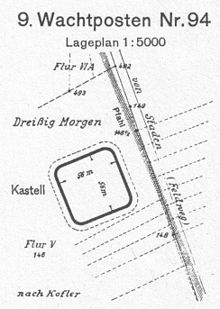Small fort Staden
| Small fort Staden | |
|---|---|
| limes | ORL - ( RLK ) |
| Route (RLK) | Upper German Limes, route 4 (Wetterau route) |
| Dating (occupancy) | unsure |
| Type | Small fort |
| unit | unknown |
| size | 56 × 56 m = 0.36 ha |
| Construction | Stone fort |
| State of preservation | Ground monument, not visible |
| place | Florstadt - Staden |
| Geographical location | 50 ° 19 '35.1 " N , 8 ° 54' 54" E |
| height | 147 m above sea level NHN |
| Previous |
Small fort Lochberg (north) |
| Subsequently |
Stammheim small fort (south) |
| Backwards | ORL 19: Fort Ober-Florstadt (west) |
The small fort in Staden , also known as the small fort on the Thirty Morning or according to the numbering of the Reichs-Limeskommission Wp 4/94 , is a former Roman fort on the Wetterau line of the Upper Germanic-Rhaetian Limes . It is located in Staden , Florstadt municipality in the Wetterau district in Hesse . The facility is now under arable land and nothing is visible on site.
location
Small fort Staden is located on the southern outskirts of the village in a new building area. The area was acquired by the municipality and development is not expected. It once occupied the highest point of a knoll, which made it possible to see the valley of the Nidda flowing north for several kilometers. To the rear, about 2.6 km away, was the Ober-Florstadt cohort fort , from which Staden and the two small fort located north ( KK Lochberg ) and south ( KK Stammheim ) were manned. There was visual contact with the fort.
Fort
The small fort was discovered and examined in 1886/87 by the route commissioner of the Reich Limes Commission (RLK), Friedrich Kofler . At that time, a slight elevation in the ground was still visible, Roman pottery shards lay on the surface. Kofler was able to expose the entire foundation of the enclosing wall.
The facility had a square floor plan of 56 × 56 m with rounded corners. Despite the complete exposure of the wall, no gate passage could be detected. The wall foundation was up to 2.25 m wide and about one meter deep into the ground. It consisted of local white sandstone. A trench five meters wide and one meter deep was found on the outside.
Kofler interpreted the remains of dry masonry, burnt clay and charcoal inside as traces of the interior development. Only a single bronze coin of the Emperor Nerva and a brick stamp of the Legio XXII Primigenia are documented.
Limes course from the small fort in Staden to the small fort in Stammheim
The Limes runs in the Florstädter district through intensively agriculturally used area and is not visible, as is the small fort Stammheim to the south-southeast, to which the distance is 1,600 m. Since the middle of this route lies exactly in a valley, the Imperial Limes Commission suspected two watchtowers between the small forts (Wp 94a and 94b). Archaeological findings are not available for either of the two locations.
Monument protection
As part of the Upper Germanic-Rhaetian Limes, the fort and the facilities mentioned have been part of the UNESCO World Heritage since 2005 . There are also ground monuments according to the Hessian Monument Protection Act . Investigations and targeted collection of finds are subject to approval, and accidental finds are reported to the monument authorities.
See also
literature
- Eduard Anthes, Friedrich Kofler and Wilhelm Soldan: stretches 4 and 5 (the Wetterau line from the Köpperner Tal near the Saalburg to the Main near Gross-Krotzenburg). The route description. In: Ernst Fabricius , Felix Hettner , Oscar von Sarwey (eds.): The Upper Germanic-Raetian Limes of the Roemerreiches / Dept. A, Vol. 2, routes 4 and 5 (The Wetterau line from the Köpperner Tal near the Saalburg to the Main near Gross- Krotzenburg) , 1936, pp. 141 and 143.
- Dietwulf Baatz in: D. Baatz and Fritz-Rudolf Herrmann (eds.): The Romans in Hessen . 3. Edition. 1989. Licensed edition Nikol, Hamburg 2002, ISBN 3-933203-58-9 , pp. 408f.
- Dietwulf Baatz: The Roman Limes. Archaeological excursions between the Rhine and the Danube. 4th edition. Gebr. Mann, Berlin 2000, ISBN 3-7861-2347-0 , p. 166.
- Christian Fleer: Typification and function of the small buildings on the Limes. In: E. Schallmayer (Ed.): Limes Imperii Romani. Contributions to the specialist colloquium “Limes World Heritage Site” in November 2001 in Lich-Arnsburg. Bad Homburg v. d. H. 2004, ISBN 3-931267-05-9 , pp. 75-92 (= Saalburg-Schriften 6).
Remarks
- ↑ Wp = W oh p east, watch tower. The number before the slash denotes the Limes section, the number after the slash denotes the respective watchtower.
Individual evidence
- ↑ ORL A p. 143.

